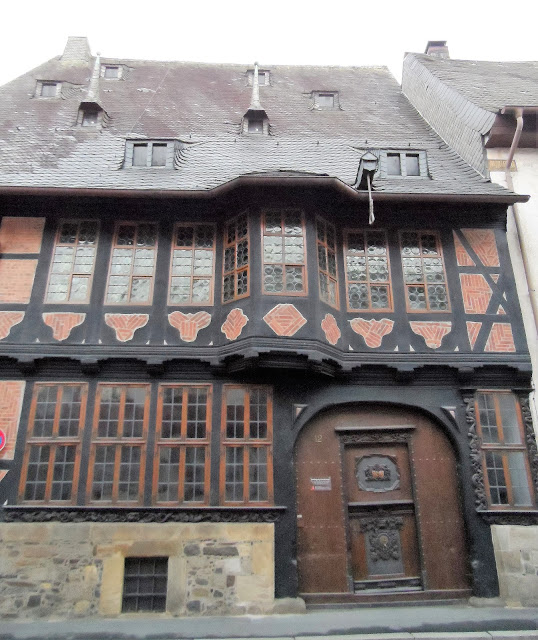We are currently parked up at Bad
Salzuflen (N52.09868 E08.74569). It has
all the usual facilities for motorhomes plus metered electric, so all is good. We are just using it as a stop over point as
we make our way closer to Holland - our 20th country in 11 months and our last before heading back to good old blighty! It
was a drive of nearly 100 miles today – a long but pretty drive through a lot
of countryside and villages. We were
surprised to see a lot of these signs along all of the roads we travelled today.
 |
| Weight limits for military vehicles going across bridges |
Mel has been feeling a little emotional these
last few days, reminiscing back to his time spent working in the former East
Germany in the 1980’s – Potsdam, East Berlin, Dresden, etc. I have known him for 31 years and over the
last couple of days he has been telling me stories of his time spent in East
Germany that he has never told me before!
Leaving Potsdam, we took the motorway
nearly all the way to Magdeburg, in the Saxony-Anhalt region. Often described as Berlin in miniature,
four-fifths of the city was destroyed by bombs in WWII.
 |
| Reconstruction of the old centre began in 1951 and commemorated by this stone on the Bärbogen Gate |
That said, there are still a lot of historic
medieval buildings, lovely baroque facades and plenty of churches going back
some 1200 years. We parked up on a
lovely camper stop next to a marina on the River Elbe, which runs through the city (N52.12509 E11.64866).
 |
| Sonny(our motorhome) enjoying a lovely view across the old city. of Magdeburg |
The city was made great by Emperor Otto
I, who chose it as his main residence making it a significant political and
cultural centre in medieval times and giving it Germany’s oldest cathedral.
 |
| Mel loitering under Magdeburg’s only remaining preserved medieval city gate and half-timbered building in the old city |
 |
| Otto-von-Guericke, famous for his physics experiments (inventor of the vacuum pump) and one of the most important natural scientist of the 17th century |
 |
| It's that time of year again - getting ready for the Christmas Market in front of the old town hall |
Two Baroque patrician houses
still stand on the street that was one of the most magnificent Baroque
boulevards in Germany.
Modern architecture has found it's way into the city in the form of The Green Citadel of Magdeburg – a very pink, curvy and zany form of architecture by Friedensreich Hundertwasser. It is a mix of apartments, shops, offices and
a hotel.
 |
| Who would live in a house like this?! |
 |
| You can’t come to Germany and not have a piece of Black-Forrest Gateaux, although I opted for one laced with Baileys… hic! |
Magdeburg lies at the intersection of
the Northern and Southern route of the Romanesque Road and leaving the city we
continued to travel along this route. You
can stop off along the ‘tourist trail’ and take in more 10th century
churches, cathedrals, monasteries and castles, we chose not to stop (we had
seen way too many churches and cathedrals over the last few months!) and just
took in the sights as we passed through the towns/villages. The countryside reminded us very much of
Slovakia and the Czech Republic. We
crossed from the former East Germany into West Germany and stopped off at
Goslar, in the foothills of the Harz mountains.
Goslar is a little treasure of a town,
with its Romanesque architecture and an old town of medieval timber-framed
beauties. It is one of those towns that you can
get lost in wandering up and down the cobbled streets.
 |
| The market square - 15 the century Rathaus and 12th century fountain topped with the symbol of Goslar - an eagle and 15th century guildhall decorated with strange looking baroque wooden sculptures |
 |
| Mel's impersonation of Goslar Nail Head! They were used as a form of propaganda in WWI |
The carillon bells and figures
chime 4 times a day on top of the old treasury building. A funny parade
spinning from the Glockenspiel, commemorating
1,000 years of mining. It lasted about 7 minutes and had children engrossed and us grinning from ear to ear. We were the only adults without children watching I hasten to add!
The making of the town came in the 10th
century with the discovery of silver and transformed it into one of norther
Europe’s leading medieval towns and there are some lovely former miners houses along the cobbled streets.
 |
| The Baroque Siemenshaus was the mid 19th century home of the Siemens family who founded what became today's global corporation. |
 |
| The Romanesque Imperial Palace |
Leaving Goslar, we parked up for the
night, nestled in the Harz Mountains at a place called Lautenthal (N51.87020 E10.28729). It’s free to park you just pay €1 for water
and the same for your chemical waste, and electric hook-up is metered.
The northern Germans refer to the Harz mountains as their mini-Black Forest. They are not high peaks but more thickly wooded hills covering an area of about 100km long by 30km wide. Mel came skiing here back in the mid 80s, when he lived in Potsdam – we didn’t see any snow but it was cold. At 5pm the outside temperature was only 1.8°C brrrrr! We had put a few euros in the meter, so our electric heater was ramped up to the full! Fingers crossed for a warmer night
tonight!
Sally x








No comments:
Post a Comment